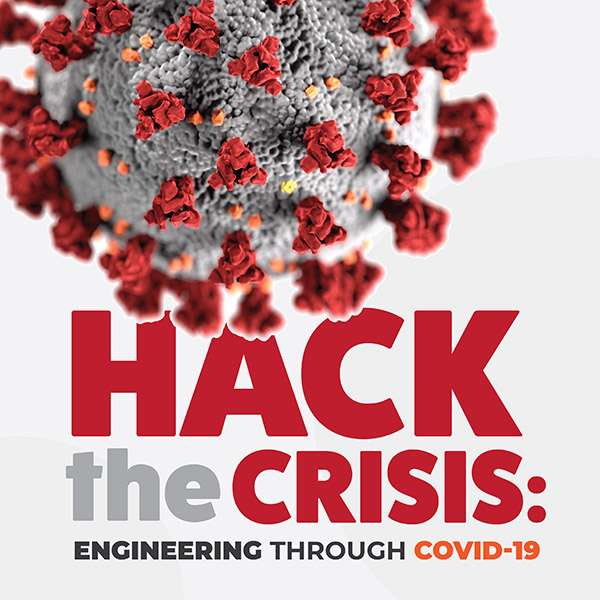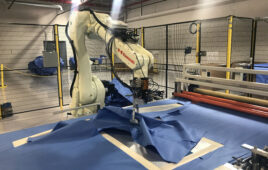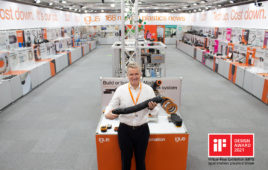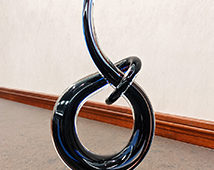 As part of our series, “Hack the Crisis,” Design World’s VP, Editorial Director Paul J. Heney recently interviewed UL’s Director of Global Life & Health Sciences Regulatory & Testing Assurance, Deborah Jennings-Conner.
As part of our series, “Hack the Crisis,” Design World’s VP, Editorial Director Paul J. Heney recently interviewed UL’s Director of Global Life & Health Sciences Regulatory & Testing Assurance, Deborah Jennings-Conner.
Jennings-Conner had some great advice for keeping teams happy and motivated, as well as offered substantive advice for manufacturers looking at transitioning to producing equipment like ventilators. And she offered some smart advice for engineers to keep in mind for working beyond the crisis — some of this innovation in product design could really help our industry and individual companies in the long term.
Jennings-Conner’s work encompasses Medical Quality Management Systems, Medical Device Safety Testing and Certification, Healthcare Use Laboratory Equipment Testing and Certification, Nurse Call and Assisted Living Equipment, Personal Health & Hygiene Appliances and other medical adjunct services. She holds an Electrical Engineering Technology degree from Old Dominion University and has more than 32 years of experience at UL, with the last 17 years serving the Healthcare Industry.
[Following is a lightly edited transcript.]
DW: I’m Paul Heney, VP, Editorial Director of Design World. I’m joined here today by Deborah Jennings-Conner, who is UL’s Director of Global Life and Health Sciences Regulatory and Testing Assurance. Thanks for joining us today, Deborah.
DJC: Thanks, Paul, glad to talk with you today.
DW: First off, can you give us an idea of the COVID-19 crisis has affected the team there at UL? How is social distancing and working at home being implemented?
DJC: Absolutely. UL has been dealing with the crisis for several months now. We are a global operation, and we have people in China. We actually started with the crisis situation early on, late last year. I’m not sure exactly which month we started, but early on, we started having our engineering staff work from home. We were still having our internal offices open with our laboratory staff who need to test samples, and we put a lot of safety measures in for those staff such as working multiple shifts, having less people near each other in the office.
I had some really nice pictures from some of our team in Europe where they had actually used their six-foot measuring tapes to show their distancing between their rows and they were having a lot of fun with it. We want the people that are in the office to feel very secure. So, we pretty much have all of our engineering staff at home.
I would also highlight something I thought that has been really fabulous — our president and CEO, Jenny Scanlon, sends a video out to us from her home every week and it just really helps to keep us motivated. She lets us know what we are doing for all the staff around the world. We know which offices are open or closed or partially working with the technicians, and it’s been really fabulous.
And I would also ask you to go and take a look — she did a video for the UN, a lot of the CEOs did a video for the UN about how they are supporting their internal staff, following the country or local rules at each of the offices. And it’s been really a phenomenal process at UL to be able to continue to work remotely. And those who are in the office are still doing it in a really safe manner.
DW: That ties into maintaining employee productivity. How are you achieving that as well as just kind of mental health and worker morale?
DJC: Really good question, Paul. We’ve been working on that a lot. One of the great things we’ve done is have tools that allow us to do video like this one. We’ve encouraged all of our teams, or at least I have. I make them all turn their video on. It almost seems like you could possibly be in the same room if you have your video on and just keeping their motivation. I have one little thing that I started with the team and it’s called one word. At the beginning of every call, we ask each person to say only one word. It’s hard for them sometimes, but just one word of how they’re feeling today. And like my word yesterday was cold because it was a little chilly down here in the South, but just one word.
It just gives an icebreaker and then we also are having a lot of fun in addition to our work and getting day to day work done, some of the teams on Fridays, and I occasionally get invited, not always as the boss. But occasionally get invited to their Friday afternoons social COVID hour. So, it’s just have to turn their video on. There’s no discussion about work at all and they just talk about fun stuff. The Friday before last, it was “bring your pet” and it was very fun. All of us had our pets. My cat, Harley, was sitting up on the back of my chair here like he normally does.
I know one of the teams did their favorite teams. So, they wore their favorite team gear. It’s not only trying to work, but trying to stay connected because everyone, you may have your family at home with you, spouse, the kids. Allowing people to also work flexible hours. We’ve had some people who say, “Hey I need to share the desk with my spouse. They work morning, I work afternoon.” Just being able to continue to keep work going, but making sure we have that personal touch, that personal connection at least once a day.
DW: I’m stuck on the one word — I’m trying to decide if “Tiger King” counts as one word or not. Probably not.
DJC: I usually do get the question of can they hyphenate a word? Or they make up new words. It’s hard to get anyone in my team just to say one word, including me.
DW: I bet! So, Deborah, anyone who’s been around designworldonline.com the last month has probably noticed there’s a lot of manufacturers out there that are trying to transition into producing equipment like ventilators. I’m assuming that’s not an easy task. Could you talk manufacturers through a little bit? What’s the thinking if they’re considering retooling their factories in this sort of way given the current regulatory environment?
DJC: Paul, you’re right, it’s really not an easy task for a new manufacturer to start producing in the medical world. The medical world is highly regulated by the FDA in the U.S. They have a lot of what we call quality system regulation rules that are in place. My suggestion to someone who really wants to help out, first see if you can partner with someone who’s already in the industry. If you’re wanting to manufacture a ventilator and you’re able to connect with someone who already has an FDA cleared device, it’s an easier path. In that case, it’s more of just adding an alternate manufacturing location under the current manufacturers, what we call the quality management systems. There’s a lot of rigor. A lot of it has to do with the quality system in the factory. And the quality system helps you to ensure that the product, as designed and approved, once it gets out the door, it is safe and effective, and is the FDA cleared version.
If you’re a manufacturer that wants to start from scratch, under the emergency use situation that we’re in, the FDA has posted guidelines for many types of medical products. But in particular for ventilators, there is an emergency use authorization for ventilators. Any new manufacturer that would like to try to produce, they can email the FDA, they can call the FDA, and they could propose their design. And the FDA will get back with them as to whether they could do something under a short condition or not. But the minimum that they’re going to need to have in place is going to be a quality management system. Some, a review of their design. It’s not going to be a real easy process to get through. There’s more than 20 different standards for different types of ventilators, and you’re going to need at least to prove some level of basic safety and essential performance and that you can produce it in a quality manufacturing way. The key is just making sure you produce it exactly as it was intended.
DW: Sure. What about like training and employee expertise, which may not be at the highest level if they’ve never produced this product before?
DJC: That’s another very good point, Paul. Training and education of the employees is extremely important. If a product is coming down the production line gets stopped for some reason, the enclosure has a problem, or the switch won’t fit, or I’m missing the switch that was originally designed to go in there. The employees need to be trained that it’s not acceptable to go grabs switch “B” out of the bin that is full, versus switch “A” out of the bin that’s empty. So, there is a lot of rigor and rules around the people are trained properly to know these situations and how to handle the exceptions to the situations.
It’s very important. I would say manufacturers that have worked in a basic quality management system, which is called ISO 9001, they would have a good idea of the rigor around this process, not just the manufacturing but even the procurement, ordering the correct parts such as that. Medical has its own quality management system, ISO 13485, and I lovingly refer to that is ISO 9001 on steroids.
It is all the basic quality plus the extra that you do need for medical. And even to the point that a brand-new manufacturer would need to be ready to report back to the FDA if their devices in the field had any adverse effects. There’s a lot of rigor around that. You would need to be ready for that. Even under the emergency use authorizations, there is going to be a specific framework that a manufacturer will need to comply with. The FDA didn’t specifically state that framework, but they’re open for conversations with potential new manufacturers.
DW: Okay, and then what about like environmental considerations, whether that be sterilization or clean rooms? I’m guessing that comes into play at some point.
DJC: It definitely would. For basic manufacturing, you would certainly need a clean environment to manufacturer a ventilator. For where sterilization would come into place would be devices, or packs, or parts, or accessories that may come in a sterile pack. For example, when we go to the dentist, we get our own personal blister pack of sterile equipment that the dentist has just for us, so they are not sharing between people. This is a harder manufacturing to start up from scratch. My expectation would be that if a ventilator or any other product had a sterile accessory, you would still get the sterile accessory from an already approved manufacturing location and then you would pair that with the device for ultimate shipping. I would say it’s pretty tough to start from scratch right now and move in a really fast way that will help out the crisis for producing sterile products.
DW: What about if manufacturers have to acquire specialized parts or maybe medical grade textiles or something they are not used to acquiring? What suggestions do you have in that kind of area?
DJC: This is a really hot topic right now, Paul. We are hearing from everyone that they are running into trouble with their supply chains. There is definitely supply chain disruption. So even if you have an open source design for a ventilator, you may not be able to find all the parts that you need. We’re running into issues where maybe many of these parts might be manufactured in another country that’s also affected by the virus, such as China. The parts may be there, but we can’t get them shipped because not as many planes are flying or whatever reason that they’re delayed. Just giving a bit of feedback, there are ways to add alternative components. UL works on this a lot and we are trying to help with this in this situation in the crisis to quickly get parts approved as alternates. We have the ability to witness testing for customers via video.
We may need to do an audit. We also have authorization to do quite a bit of that via videos. There’s a lot of ways we can help customers, you know, to get those alternative components, if they’re dealing with supply chain issues, to get them done quickly. I would also recommend anyone that is trying to source alternate components, UL has a free resource on ul.com and it’s called the Product IQ. If you just search for that in the search field, it’s a free online database of all of our certified components. If you need to find an alternate plastic material for the enclosure, for example, you would be able to put in some parameters about that plastic and find all the manufacturers. So, you may be able to source someone that you didn’t normally, wouldn’t otherwise normally have been able to find.
DW: Great information. Thank you. Deborah, taking a step back — we’re both engineers, so engineer to engineer I’m kind of curious as to your big picture thoughts on this. Do you think engineers can maintain their creativity in times like this where we have limited physical interaction with our other team members?
DJC: Absolutely. I think it’s not only as easy, but what we’re learning internally is there’s a lot of technical tools that we have that can help us still stay connected. For example, our internal collaboration toll for online, it has a whiteboard, it has a way to collaborate online. Multiple people could be working on something at the same time. I mean I definitely think getting on the phone with a video is a good way to continue to have collaboration, show inclusiveness, and make sure people are heard and can participate.
I do believe that we can keep working and we can keep collaborating even though we’re remote. But I do believe the use of the technology that we have. I know yesterday I saw a company that had a very interesting 3D modeling of some computer designs and how we might be able to use that to review a whole construction, I guess the standard without ever really seeing a sample, which could be kind of interesting.
We really hadn’t thought of that before. We use drawings of course, but this tool was really cool. It was able to show a 3D modeling of the ventilator. Most people heard already, Medtronic was nice enough to make one of their more-simple ventilators open source information on their design and all the other materials you would need to try to manufacture one of those. Perhaps you look at a 3D model of that, it would help you figure out how do I source these parts? Do I need to change this part slightly? And then you could go back to the FDA and get an alternative use of the component, which they’re also willing to look at as well too. I do believe that there are ways that our engineering teams can certainly collaborate virtually.
DW: Wonderful. Wrapping up, do you have any warnings or advice or encouragement that you want to give your colleagues in the manufacturing world here?
DJC: Absolutely. Being an engineer, having worked at UL for 32 years, we’ve seen some crisis situations and we have our normal situations. It seems when we’re in a normal situation, if someone has a new idea or a new idea about a product or a process, we can find 20 or 30 ways to say that we could never do that. Or we might look at it next year. But it’s usually never a fast process to make maybe what could be a good idea. But in this crisis situation, both at UL and what I’ve seen around the world, we have managed to quickly move forward on innovative, creative ideas and we have found a way to say yes. Not that we’re cutting any corners, not that we’re doing what we shouldn’t be doing, but we’ve managed to say yes to doing things the right way.
I have a colleague of mine, he always says, “Make the right way, the easy way.” And I think it’s so true. I think the thing that we could learn, the hope we have from this situation is if we can have that innovation in the crisis situation, why can’t we have that innovation all the time? I think it’s just a really positive thing to see that. I also believe that some of the product ideas that we have going on now, my hope is that they’re not just used in this crisis situation, but that they permanently become part of our healthcare system. Because you never know when there might be another crisis. We hope we don’t have one, but some of this innovation in product design could actually help us in the long term, not just in this short-term crisis.
DW: All right. Deborah Jennings-Conner of UL. Deborah, thank you so much for all of your insight, for all the work that you’re doing in this crisis and for joining us for a few minutes here today.
DJC: Great. Thanks, Paul. It’s been my pleasure.
Filed Under: Fighting COVID-19




